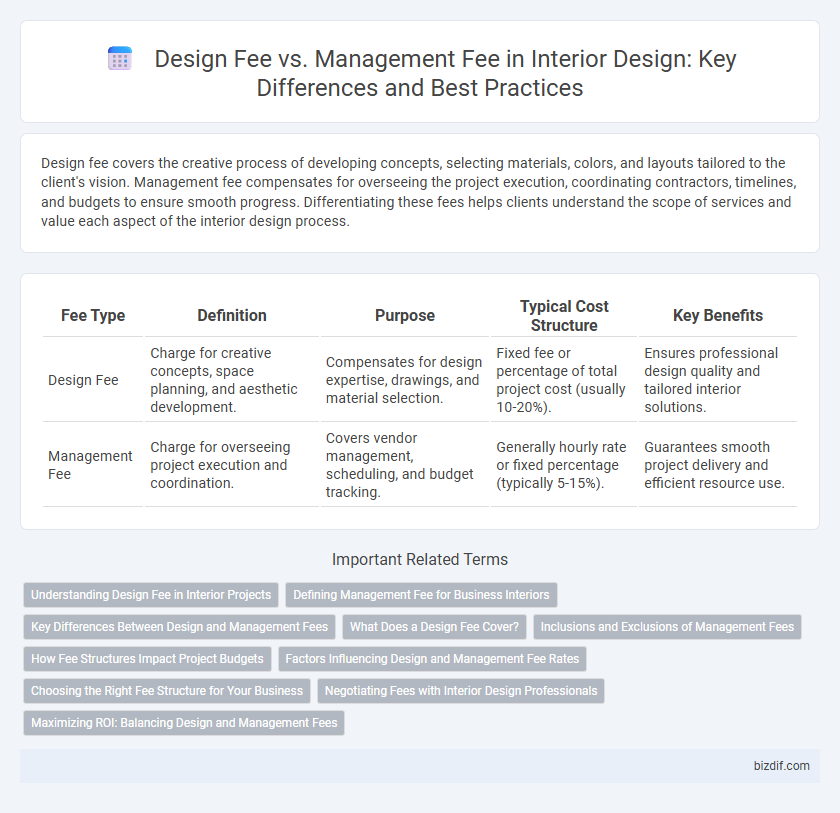Design fee covers the creative process of developing concepts, selecting materials, colors, and layouts tailored to the client's vision. Management fee compensates for overseeing the project execution, coordinating contractors, timelines, and budgets to ensure smooth progress. Differentiating these fees helps clients understand the scope of services and value each aspect of the interior design process.
Table of Comparison
| Fee Type | Definition | Purpose | Typical Cost Structure | Key Benefits |
|---|---|---|---|---|
| Design Fee | Charge for creative concepts, space planning, and aesthetic development. | Compensates for design expertise, drawings, and material selection. | Fixed fee or percentage of total project cost (usually 10-20%). | Ensures professional design quality and tailored interior solutions. |
| Management Fee | Charge for overseeing project execution and coordination. | Covers vendor management, scheduling, and budget tracking. | Generally hourly rate or fixed percentage (typically 5-15%). | Guarantees smooth project delivery and efficient resource use. |
Understanding Design Fee in Interior Projects
Design fee in interior projects encompasses the cost for conceptual development, space planning, material selection, and creating detailed drawings tailored to client requirements. It typically reflects the designer's expertise, project complexity, and time invested in crafting aesthetic and functional solutions for residential or commercial spaces. Understanding design fees helps clients budget accurately and ensures transparent communication regarding the scope of creative services provided.
Defining Management Fee for Business Interiors
Management fees for business interiors encompass the comprehensive coordination of project execution, including vendor supervision, scheduling, and quality control to ensure that design objectives align with operational functionality. These fees cover administrative services beyond the initial design concept, focusing on the seamless implementation and ongoing oversight of interior environments within commercial spaces. Accurately defining management fees highlights their role in mitigating risks and optimizing resource allocation throughout the construction and installation phases.
Key Differences Between Design and Management Fees
Design fees primarily cover creative services such as conceptualizing layouts, selecting materials, and developing visual plans, while management fees are associated with overseeing project execution, budgeting, scheduling, and coordinating contractors. Design fees are typically calculated as a percentage of the project cost or a fixed rate for design deliverables, whereas management fees may be charged hourly or as a portion of the overall construction expenses. Understanding these distinctions helps clients allocate budgets effectively and ensures clarity in contract terms between interior designers and project managers.
What Does a Design Fee Cover?
A design fee typically covers the conceptual development, space planning, and selection of materials, colors, and finishes in an interior design project. It includes creating mood boards, detailed drawings, and 3D renderings to visualize the final space. This fee also accounts for client consultations and revisions to ensure the design aligns with the client's vision and functional needs.
Inclusions and Exclusions of Management Fees
Management fees in interior design typically include project oversight, coordination with contractors, scheduling, and quality control throughout the construction phase. These fees exclude direct costs such as materials, labor charges, permits, and subcontractor expenses, which are billed separately. Clear distinction between design fees, covering concept development and space planning, and management fees ensures transparent budgeting and scope definition for clients.
How Fee Structures Impact Project Budgets
Design fees typically cover conceptual planning, material selection, and aesthetic consultation, directly influencing the initial budget allocation for interior projects. Management fees encompass project coordination, scheduling, and contractor supervision, affecting ongoing expenses and overall timeline efficiency. Understanding the distinction helps clients allocate resources accurately, preventing budget overruns and ensuring transparent financial planning throughout the design process.
Factors Influencing Design and Management Fee Rates
Design and management fee rates in interior design vary based on project scope, complexity, and client requirements, with larger or more intricate spaces typically demanding higher fees. Geographic location and the designer's expertise or reputation also significantly impact pricing structures. Additionally, the level of project oversight, including coordination with contractors and timelines, influences the management fee percentage charged.
Choosing the Right Fee Structure for Your Business
Selecting the appropriate fee structure between design fees and management fees depends on the scope and scale of your interior design projects. Design fees typically cover creative services such as concept development and material selection, while management fees include overseeing project execution, scheduling, and vendor coordination. Understanding your business model and client expectations ensures alignment with profitability and service delivery goals.
Negotiating Fees with Interior Design Professionals
Negotiating fees with interior design professionals involves understanding the distinction between design fees, which cover concept development and creative services, and management fees, charged for overseeing project execution and vendor coordination. Clear communication about scope, deliverables, and budget allows clients to negotiate flexible fee structures that align with their specific needs and project complexity. Establishing a detailed contract with transparent fee breakdowns ensures both parties agree on payment terms and avoids unexpected costs during the interior design process.
Maximizing ROI: Balancing Design and Management Fees
Maximizing ROI in interior design requires a strategic balance between design fees and management fees, where effective allocation ensures high-quality aesthetics while controlling project costs. Design fees cover conceptual development and creative expertise, driving unique and functional spaces, whereas management fees focus on overseeing project execution, timelines, and vendor coordination. Prioritizing transparent fees and value-driven services boosts client satisfaction and optimizes investment returns throughout the project lifecycle.
Design Fee vs Management Fee Infographic

 bizdif.com
bizdif.com